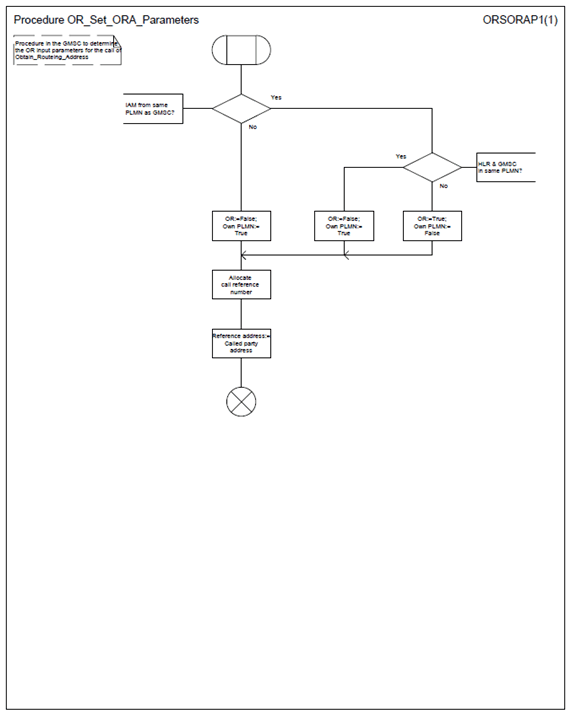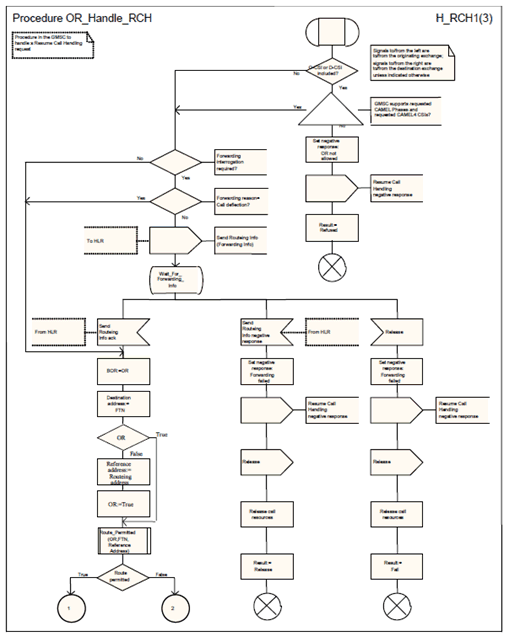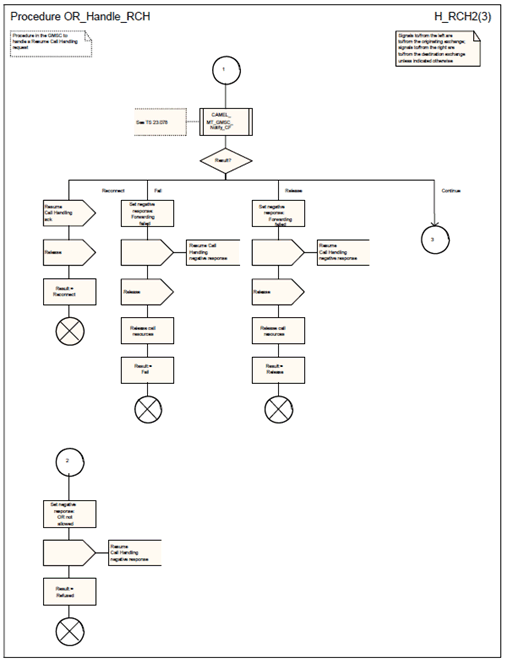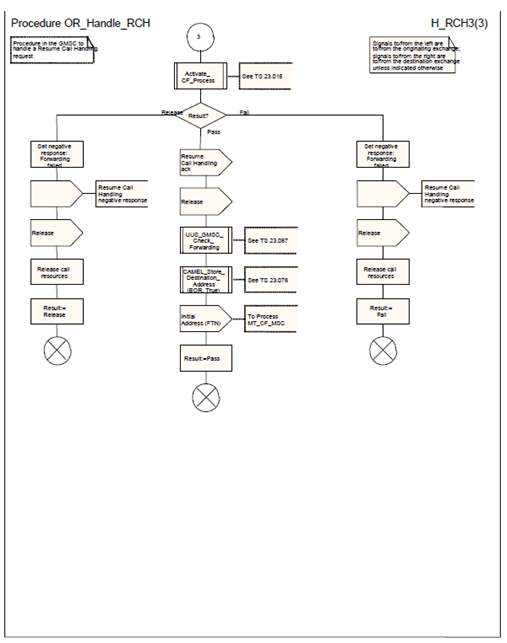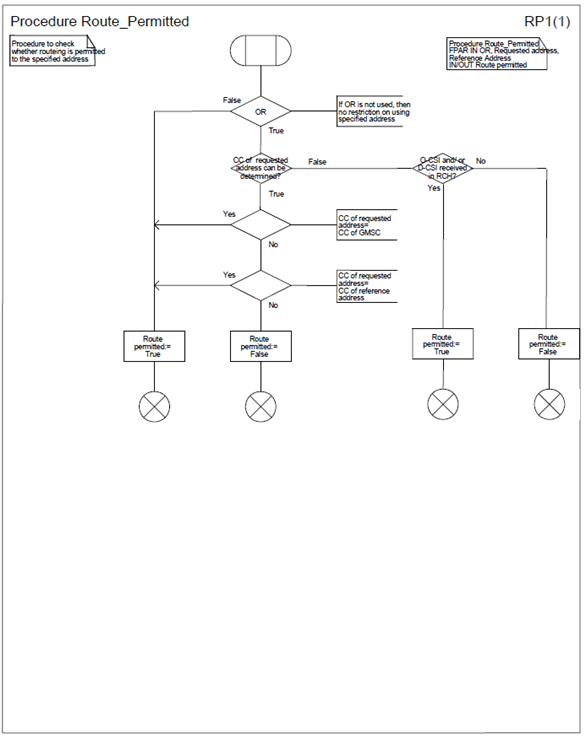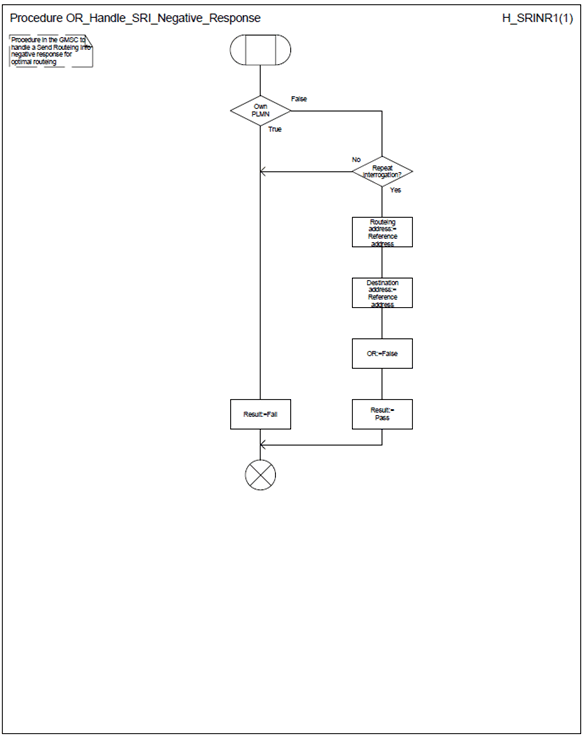Content for TS 23.079 Word version: 18.0.0
9 Functional requirements of entities performing optimal routeing
9.1 Charging requirements for optimal routeing
9.2 Functional behaviour of VMSCA
9.3 Functional behaviour of VLRA
9.4 Functional behaviour of GMSC
9.4.1 Procedure OR_Set_ORA_Parameters
9.4.2 Procedure OR_Handle_RCH
9.4.3 Procedure Route_Permitted
9.4.4 Procedure OR_Handle_SRI_Negative_Response
...
...
9 Functional requirements of entities performing optimal routeing p. 20
9.1 Charging requirements for optimal routeing p. 20
MoU have imposed two constraints for the charging of optimally routed calls:
- No subscriber shall pay more for a call which has been optimally routed than he would do under the present routeing scheme described in GSM 03.04 [1] in the clauses describing the call cases where the GMSC is in the same PLMN as the HLR.
- At least for the first phase of Support of Optimal Routeing, the charge for one leg of a call shall be paid for entirely by one subscriber.
- If the country code of the destination exchange and the country code of the GMSC are the same, then the direct route may be used.
- Otherwise, for a call leg which is chargeable to the A subscriber, if the country code of the destination exchange and the country code of HPLMNB are the same, then the direct route may be used.
- Otherwise, the HPLMN route shall be used.
- if the country code of the forwarded-to exchange and the country code of the GMSC are the same, then the forwarded call may be routed directly from the GMSC to the forwarded-to exchange;
- otherwise, if the country code of the forwarded-to exchange and the country code of HPLMNB are the same, then the forwarded call may be routed directly from the GMSC to the forwarded-to exchange;
- otherwise, if the country code of the forwarded-to exchange and the country code of VPLMNB are the same, then the forwarded call may be routed directly from the GMSC to the forwarded-to exchange;
- otherwise the forwarded call shall be routed through VPLMNB.
9.2 Functional behaviour of VMSCA p. 21
The functional behaviour of VMSCA is specified in TS 23.018. The only functions specific to optimal routeing are:
- Routeing the call to the associated GMSC function if the gsmSCF indicates that the call is eligible for optimal routeing;
- The transfer of the destination address, if it is received in the indication of the answer event, to the call data record, to allow the correct charge for the call to be made. This function is required only if VMSCA supports optimal routeing of mobile-to-mobile calls.
9.3 Functional behaviour of VLRA p. 21
The functional behaviour of VLRA is specified in TS 23.018.
9.4 Functional behaviour of GMSC p. 21
When a call is being forwarded the forwarding leg is controlled by a process MT_CF_MSC which runs in the forwarding MSC (VMSC or GMSC). If CAMEL processing of the forwarding leg indicates that Basic Optimal Routeing of the forwarding leg should be attempted, the forwarding MSC may use the services of an associated GMSC for the forwarding leg, i.e. the associated GMSC requests routeing information from HLRC. In this case, the forwarding leg is processed in the same way as a mobile-originated call from mobile subscriber B.
The functional behaviour of a GMSC is specified in TS 23.018. The procedures specific to Support of Optimal Routeing are specified in this clause.
9.4.1 Procedure OR_Set_ORA_Parameters p. 21
9.4.2 Procedure OR_Handle_RCH p. 21
Sheet 1:
if the GMSC receives O-CSI or D-CSI in Resume Call Handling, then the GMSC shall verify whether it supports the CAMEL Phases indicated in O-CSI and D-CSI. If either or both of O-CSI and D-CSI indicates CAMEL Phase 4, then the GMSC shall also verify whether the Offered CAMEL4 CSIs of the GMSC includes support for O-CSI and D-CSI. If the required CAMEL Phases or the required CAMEL4 CSIs are not supported in the GMSC, then the GMSC disallows the Optimal Routeing request. Refer to TS 23.078 for a description of the Offered CAMEL4 CSIs.
Sheet 1:
if the GMSC interrogates the HLR for a Forwarded-to number, the Routeing address is the Forwarded-to number received in the Send Routeing Info ack; otherwise the Routeing address is the Forwarded-to number received in the Resume Call Handling.
Sheet 1:
the task "Destination address := FTN" is executed only if the GMSC supports optimal routeing of basic mobile-to-mobile calls.
Sheet 1:
the procedure Route_permitted is called to verify the number received in Resume Call Handling or the number received from HLR. If the result is "False", then the GMSC disallows the Optimal Routeing. The call forwarding will now be done by the VMSC.
Sheet 2:
the procedure CAMEL_MT_GMSC_Notify_CF is specific to CAMEL phase 2 or higher; it is specified in TS 23.078. If the GMSC does not support CAMEL phase 2 or higher, processing continues from the "Continue" exit of the test "Result".
If the result of the procedure CAMEL_MT_GMSC_Notify_CF is "Fail" or "Release", then the call will be released.
If the result of the procedure CAMEL_MT_GMSC_Notify_CF is "Reconnect", then the GMSC allows the Optimal Routeing. The GMSC will then start a call forwarding process.
Sheet 2:
when the procedure Route_permitted on sheet 1 returns result "False", then the GMSC returns "OR not allowed" to the VMSC. The call forwarding will now be done by the VMSC.
Sheet 3:
the procedure Activate_CF_Process is specified in TS 23.018. When procedure Activate_CF_Process returns result "Release" or "Fail", the call is released.
If the result is "Pass", then the GMSC allows the Optimal Routeing.
Sheet 3:
the procedure UUS_GMSC_Check_Forwarding is specific to UUS; it is specified in TS 23.087.
Sheet 3:
the procedure CAMEL_Store_Destination_Address is specific to CAMEL phase 3 or higher; it is specified in TS 23.078.
Sheet 3:
the called party address sent in the IAM to the process MT_CF_MSC is the Forwarded-to number received in the Perform Call Forwarding ack.
Sheet 3:
the process MT_CF_MSC is specified in TS 23.018.
9.4.3 Procedure Route_Permitted p. 22
Void
9.4.4 Procedure OR_Handle_SRI_Negative_Response p. 22
'Non-fatal' error situations, which cause the call to be routed through a GMSC in the same PLMN as the HLR, are:
- Send Routeing Info request rejected because the HLR does not support OR.
- Protocol error.
- System failure.
- Unexpected data value.
- Data missing.
- OR not allowed.
- Unknown subscriber.
- Number changed.
- Bearer service not provisioned.
- Teleservice not provisioned.
- Call barred.
- CUG reject.
- Forwarding violation.
- Facility not supported.
- Absent subscriber.
